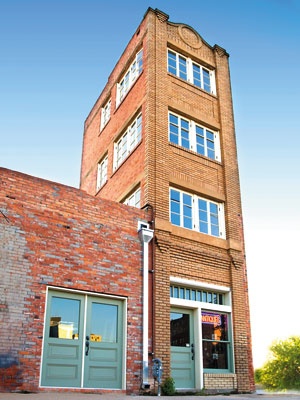In Wichita Falls, they’ve turned the state’s bragging art form on its head. Can you tell me another place in Texas where townspeople proudly boast of having the smallest tourist attraction?
Dallas and Houston may have sparkling skyscrapers so tall that they require oxygen in the penthouses, but has Ripley’s Believe It or Not ever paid them attention? Do travelers make special detours to gaze in wonder?
Visitors to the North Texas city of Wichita Falls are routinely given directions to the edge-of-downtown corner of Seventh Street and LaSalle where, since 1919, the World’s Littlest Skyscraper has stood. The four-story red brick structure, just 40 feet tall with 118 square feet per floor, has survived tornadoes and fire and years of neglect to stand as a monument to the greed and graft of the region’s long-ago oil boom days.
This is the story visitors are told:
When the discovery of black gold in nearby Burkburnett turned thousands of Wichita County residents into instant millionaires, mineral rights deals were being made on street corners and in the shade of quickly erected tents that served as oil company headquarters. There was a desperate need for office space in Wichita Falls, and a Philadelphia oil man/promoter named J.D. McMahon came running to the rescue.
With blueprints in hand, he set about quickly selling $200,000 in stock to investors caught up in the quick-buck frenzy of the day. What would result, McMahon promised, was a multistory office building that would go up just across the street from the thriving St. James Hotel.
What the promoter failed to mention, legend has it, was that the scale of his blueprints was in inches rather than feet. Apparently too busy to keep an eye on construction, investors ultimately found themselves owners of a building that looked more like an elevator shaft than high-rise office space. The completed building’s outside dimensions were a closet-sized 11 feet by 19 feet. Stairwells that led to the upstairs floors occupied 25 percent of the interior.
And by the time construction was completed, McMahon was nowhere to be found. Duped investors unsuccessfully chased after the scam artist and sought legal remedy only to be told they had no case. McMahon had built exactly according to the blueprints they’d signed off on.
Still, with office space in such demand, oil companies squeezed desks into the tiny space and called it home until the boom finally fell silent. Then came the Depression, and the little building was boarded up and forgotten.
In 1986, the city deeded the building to the Wichita County Heritage Society, which attempted to preserve it. In time, however, it was again orphaned, and there was steadily growing talk of having it demolished before the architectural firm of Bundy, Young, Sims & Potter was hired by the city to stabilize the downtrodden structure. So fascinated did Dick Bundy and his partners become with the historic site that in 2000 they arranged a partnership with Marvin Groves Electric, purchased the building and spent $180,000 remodeling it.
“Frankly,” says Bundy, “it wasn’t a very smart investment, but so many people wanted it preserved. And, it’s a unique part of our local history.” Plus, he says, it is a great conversation piece. On a recent visit to Harvard University for a conference on the construction of high-rise office buildings, Bundy casually mentioned his firm’s involvement with the World’s Littlest Skyscraper. Before the gathering ended, he was asked to the podium to tell the story of the building and his history.
Today, it serves as more than an attraction for a steady stream of curious tourists. Local antiques dealer Glenda Tate recently leased the building, which now houses her business, The Antique Wood. Upstairs, Bundy’s artist wife, Merri, has converted the third floor into her studio.
Her husband, meanwhile, is off on a new quest. He is trying to confirm that author-adventurer Robert L. Ripley gave the building its nickname and publicized it in Ripley’s Believe It or Not cartoons.
——————–
Carlton Stowers wrote about Dorothy Scarborough and her novel The Wind in Texas Co-op Power’s December 2007 edition.


